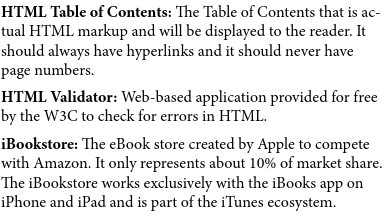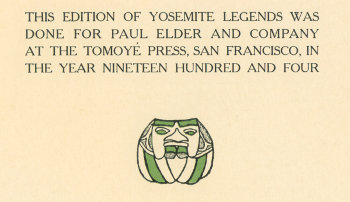Posted on 2014-May-02
The Major Components
It is recommended that most novels primarily focus on using back matter as a means of promotion of the author’s brand with the liberal use of buy links. We’ll be certain to discuss some tips and tricks in a separate post. However, for more complex works of non-fiction it may be necessary to include certain elements that are typically seen in print editions. These include:
- Appendixes
- Endnotes (usually headed as Notes)
- Glossary
- Bibliography
- Index
- Colophon
Endnotes are discussed in detail in this post, and the index will be discussed in a separate post. Let’s talk a look at some of the pieces of non-promotional back matter seen in non-fiction.
Appendixes (aka Appendices)
Appendixes are often necessary for technical works and books that require extensive research. Technical drawings, excerpts from laws, survey results, and checklists are great to put in the Appendix rather than the book’s chapters. For example, if you’re writing a book that explores the ups and downs of a complicated policy like Obamacare, you probably want to cite various portions of the law and provide some statistical evidence. However, you might bore your reader to death by using too many excerpts within the content of the book (please cf. my 2-star review of Charles Murray’s The State of White America). Rather, it may be advantageous from a reader’s standpoint to have this material conveniently in the Appendix so that the reader can easily cite if needed, but the material (often technical) does not inhibit the flow of the book.
Rather than numbers, Appendixes usually start with a letter (Appendix A, Appendix B, etc.) It’s common practice to give the Appendix a descriptive name so that it can be accessed easily through the Table of Contents as seen in the below example:

Glossary
A Glossary contains an alphabetical list of uncommon words used once or more that the reader can reference. It is almost a necessity for technical works where a lot of jargon may be used, and it can also be handy for fantasy and science-fiction authors who may develop their own language to enhance the book’s setting. The paragraph formatting is typically block style rather than first-line indent, but may be flush and hang based on the author’s preference. The word being defined is typically set in bold with a definition following a colon, period, or en dash. Below is an example of a Glossary:

Bibliography
The bibliography is a list of references cited throughout the work of the book. Unlike endnotes, you do not need to have cross-references in the book’s content every time a reference in the bibliography is utilized. It is rarely seen in fiction, but a bibliography is typically seen in more scholarly and technical works. The bibliography is organized alphabetically by the author’s last name. The format of a citation can get complicated, but a basic prototype for a bibliography entry is as follows:
Last Name, First Name. Book. Publisher, Year.
The bibliography is typically set in flush and hang style, where the first line has no indentation and subsequent lines are indented. If you have entries from the same author, one after the author, you can omit writing the name and use three em dashes instead:
———. Book. Publisher, Year.
Colophon
The Colophon is a bit obscure and probably belongs as a $2,000 Jeopardy! clue. However, the Colophon has a rich publishing tradition and you might consider using one in your eBooks on the last page. It is a single page that describes the production techniques, information about the cover, information about the interior design, and/or where the book was made. You can use this space to explain if you used any special fonts or the meaning of you cover design. Please note that this information is typically included as part of the copyright page. Below is an example of a Colophon:

Label: Technical and Design
comments powered by Disqus